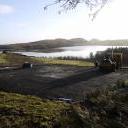Insulation 3 and rendering
The last entry was back in February when we put down some much needed flooring and we have made some progress on both the interior and exterior of the build.
The first job was insulating the first floor.
Two layers of 80mm quinn therm was then fitted between the rafters leaving a ventilation gap to the sarking/breathe membrane.
A final layer of 25mm quinn therm layer on top with a service void.
For the flat ceiling we used a couple of layers of frametherm 35 with an airtightness membrane and Quinn therm 25mm layer.
We still have some work to do around the windows.
Downstairs was a lot quicker. This already had frametherm fitted between the studs so the Quinn therm 25mm went on top.
Now for the outside. We had been waiting for good weather for rendering the blockwork.
The first step was rendering beads and mesh.
Then a scratch coat coat was added.
Then finally the rough casting.
The rough casting will now be left and painted in July.
The next step is getting the electrician and plumber to do first fix.
-
 5
5


20 Comments
Recommended Comments
Create an account or sign in to comment
You need to be a member in order to leave a comment
Create an account
Sign up for a new account in our community. It's easy!
Register a new accountSign in
Already have an account? Sign in here.
Sign In Now